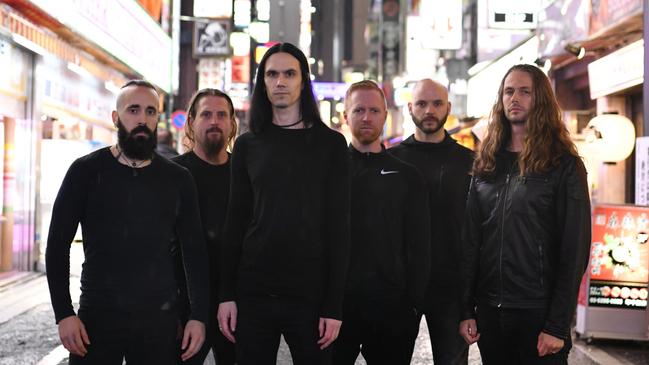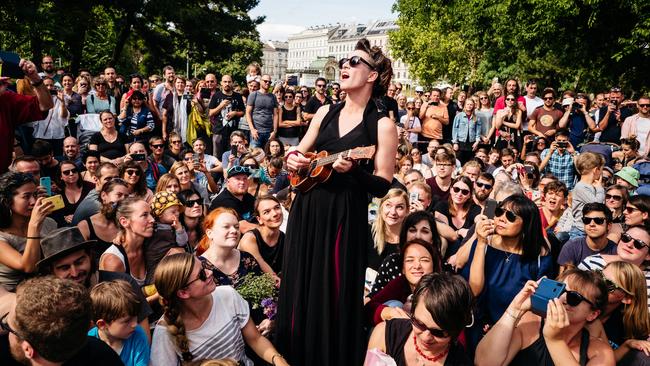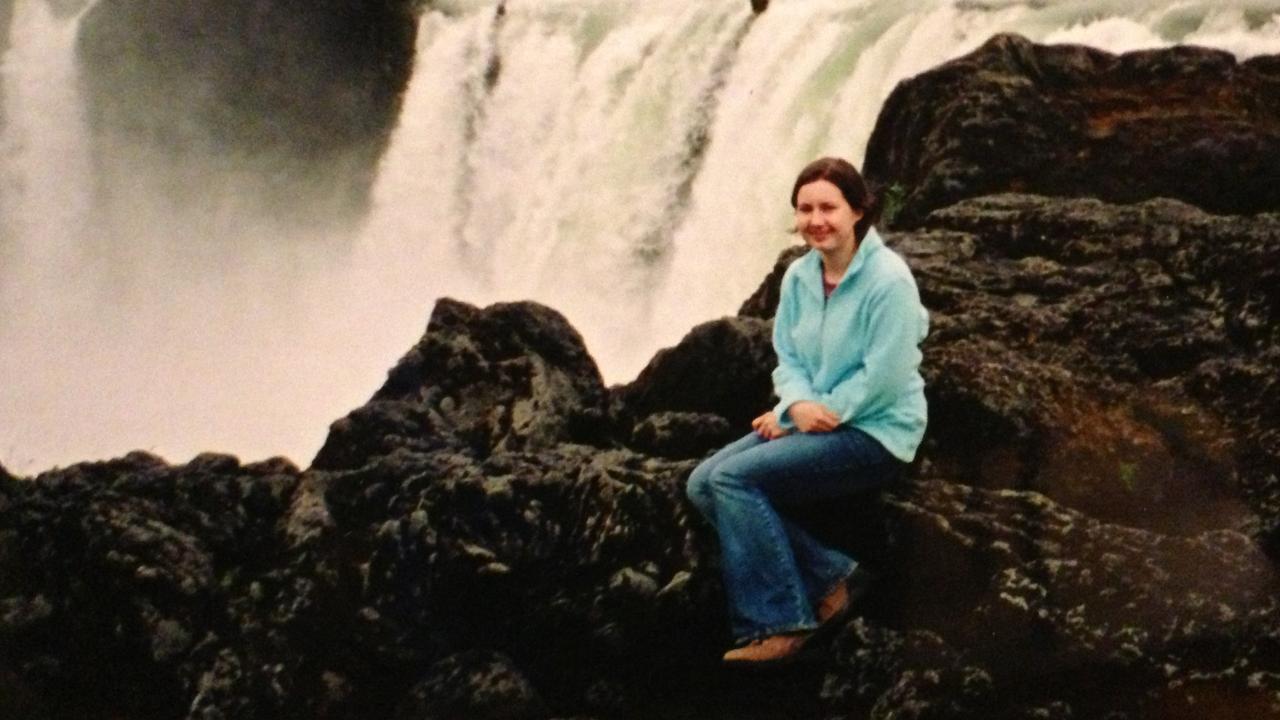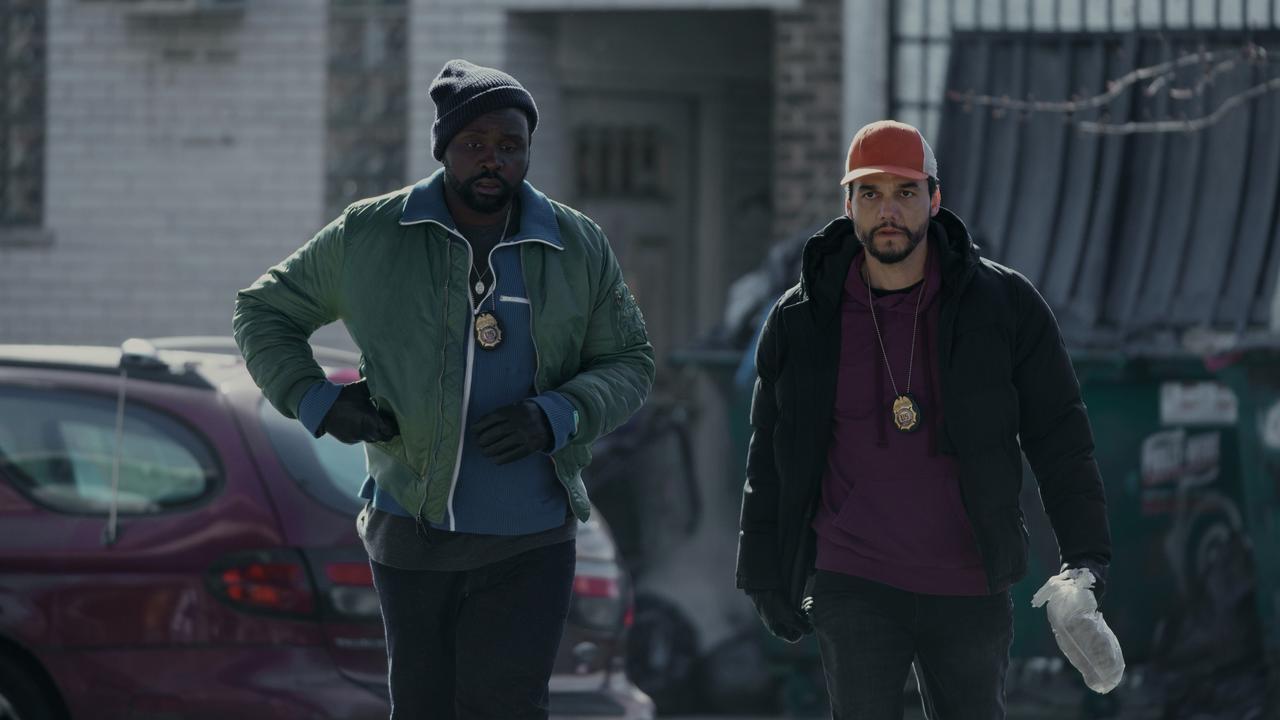On Patreon, Australian musicians find creative and financial freedom
This little-known Melbourne metal band has earned more than $700,000 directly from its devoted global fanbase since 2016. How?

With its preference for writing long, intricate arrangements built on pummelling double-kick drums, distorted guitar tones, throat-shredding vocals and occasional flourishes of violin, progressive metal band Ne Obliviscaris has not yet threatened to unseat pop stars by appearing anywhere near the top of mainstream sales charts.
Yet while the six-piece act has been steadily plying its trade to a decidedly niche audience since forming in Melbourne in 2003 and releasing three albums, there is one major chart in which the group is undoubtedly No 1.
Theirs is one of the great untold success stories of contemporary Australian music, as across five years, the band has earned more than $700,000 directly from its fans through a membership platform called Patreon.
It’s a mighty and life-changing achievement from a little-known band with a small but powerful global following, and it’s a model other artists — both groups and solo performers — would do well to strongly consider in a precarious industry still reeling from the devastating economic effects of the pandemic.
It all started when, towards the end of an American tour in March 2016, the band’s violinist and vocalist Tim Charles filmed a bare-bones video of himself near Cleveland, Ohio, talking down the barrel of a camera and making a direct appeal to join Ne Obliviscaris — whose name is Latin for “forget not” — on its journey into online patronage, which was then an unusual and largely unknown concept.
“The way the industry works is that we do this — we lose tens of thousands of dollars on every tour — and we get treated like special people, but nobody gets paid a dollar,” he said in the video. “It’s a crazy, crazy industry, and things need to change — not just for us, but for a lot of bands, to be able to keep doing this.”
His pitch was an immediate success: in its first month on Patreon, the band earned about $10,000, which allowed the six musicians to swiftly book and announce a return trip to the US within the space of a few weeks, as well as a run of European shows towards the end of 2016.
Without the support of their fans, Charles tells Review, “That tour would not have happened, because we literally just wouldn’t have had the money to get there in the first place. It was only two or three months away by the time we announced it, and it was an instant indication of, ‘Thank you for your support, and here is your thank you — we’re coming back’.”
Having previously run a world tour crowd-funding campaign in 2014 that raised $86,132 to visit the US, Europe and parts of Asia, Ne Obliviscaris knew its fans were willing to put their money precisely where their passion lay. Still, the immediate uptake from hundreds of listeners scattered around the world took the six musicians by surprise, too.
“That was very much the turning point,” says Charles, who also manages the band. “It was a very instant thing of either we’re going to shut down all our touring for a year just to try and work out how to come up with some money — or, because the Patreon was successful, actually, let’s just keep going. And it’s because we kept going that we managed to get to where we are now.”
That was nearly five years ago. As of February 2021, some 797 patrons are funding the band to the tune of about $8800 a month, in the form of a membership fee that ranges from $2 to $250.
In turn, patron rewards range from “access to exclusive giveaways and competitions and a warm fuzzy feeling inside” at the $2 tier, up to the $250 “grand master ultimate VIP” tier limited to 10 people worldwide, which includes unlimited tickets to its headline shows and soundchecks, dinner with the band when they’re in your town and the chance to hear snippets of new material before anyone else.
At Review’s request, Charles logs in to Patreon to check the band’s lifetime earnings on the platform. In its first month of March 2016, Ne Obliviscaris earned US$7499 ($9850). (Patreon operates on American dollars, but most of the earnings appearing henceforth in this story will be in Australian dollars.)
In its first year, the band earned $137,884, while as of February 9 it had made $712,085. Each of these are net earnings, after Patreon fees of between 5 and 10 per cent had been subtracted.
While it’s important to note that these figures are divided between the six band members, it still represents a substantial war chest of capital that’s well beyond the reach of all but the most successful Australian bands working today.
Even in an ordinary year, those acts are subject to income peaks and troughs depending on their recent touring activity, as well as recording and performance royalties and merchandise sales. A regular, reliable monthly wage is a rare luxury indeed.

“We create niche music; we’re never going to be the biggest band in the world whatsoever,” says Charles with a laugh. “But there are some people that really care about what we do. Most bands our size can’t tour as much as we do; they can’t invest as much on the records as we do; they can’t commit the same amount of time as we do, because they don’t have this. For a band our size, I really do think that we’re probably the highest paid band in the world per fan.”
When Review contacts one of its $250/month “grand master” super-fans to point out that his favourite band is by far the most successful Australian musical act on Patreon, Ricky Meisner is pleased to hear it.
“I believe it, and they deserve it,” says Meisner, 31, who works as a sound designer for Texas-based video game developer Gearbox Software. “Seriously, have you heard Devour Me, Colossus? It’s a journey. It’s got a bit of everything, and every second of it is such a treat for the ears, the heart, and the mind. Ne Obliviscaris stands at the pinnacle, and deserves all their success and more. And I’m proud to contribute and make a small difference.”
–
If this all sounds rather strange and new, that’s because it is. In decades past, a decision to support your favourite musician or band was chiefly confined to one of several discrete transactions: buying their music, buying their T-shirts or buying a ticket to their concert when they happened to book a show near you.
But short of handing over a cash-filled envelope to a sweaty singer or guitarist camped at the merch desk after a show, there was no other meaningful way to fund an artist directly and regularly so that they could continue to create art. Until now.
Since the beginning, much of the music industry has been built around the artist getting paid last, and least, with entities such as record labels and tour promoters — who tended to take most of the financial risk up front — being paid first and most if an album release or a tour performed well in the market. The longer these structures were in place, the harder it became for emerging artists to demand terms that were more favourable.
Because of all that historical weight and precedent, it became even harder for querulous musicians to start asking hard questions about reliable income, or their lack thereof.
Combine those realities with a deeply entrenched sense of stigma attached to the notion of asking for help — particularly because a career in the performing arts is often seen as a luxurious decision to pursue a passion, as opposed to less enjoyable careers that one might undertake to simply survive — and the result was a generation or three of artists who either resigned themselves to a precarious life of feast-and-famine income, or to eventually throw in the towel and “get a real job”, as some might say, when it all got too much.
That all changed when an American musician named Jack Conte found the economics of the music industry shifting beneath his feet. With his then girlfriend, now wife Nataly Dawn, Conte started an indie pop duo named Pomplamoose which found a wide audience performing unique covers on YouTube in 2010.
Soon, that attention translated into tens of thousands of dollars in monthly income from song downloads of their original material on iTunes, as well as occasionally playing live. As independent musicians, the pair were soon able to buy a house and set up a home recording studio; later, while pursuing solo careers on the side, Dawn raised more than $136,000 from fans to crowd-fund an album release.
When Conte spent $10,000 of his savings to film a music video for a solo song named Pedals in 2013, though, iTunes had been all but replaced among younger listeners by streaming services such as Spotify, which offered much lower revenue to artists; even clocking up one million views on YouTube might only net Conte about $100 in advertising income. So at the end of the Pedals video, Conte appeared on camera making a direct pitch to his fans asking them to join his Patreon page.
With his university friend and tech-minded co-founder Sam Yam, Conte had hurriedly set up a new website where fans who loved artists, musicians, filmmakers, podcasters and other creative workers could support them monthly, as opposed to a one-off campaign such as Dawn’s crowd-funding drive.
The 40 or so musicians who Conte had approached before Patreon’s launch had all declined his requests to join him in his leap of faith, with many of them feeling uncomfortable with the notion of asking their listeners for that sort of help, out of fear of appearing desperate. But for Conte, the results were immediate: within two months, he went from draining his savings accounts to making more than $100,000 a year for his solo career.
Numbers like those are hard to ignore, and slowly, eventually — as the Patreon co-founders sought and received venture capital funding to expand their business — other independent musicians began joining the platform.
The best-known of these was Amanda Palmer, the US singer, songwriter and pianist of punk cabaret duo Dresden Dolls who has previously raised $1.5 million from nearly 25,000 fans in an album release crowd-funding campaign held on the website Kickstarter in 2012.
Knowing that her fans were open to chipping in cash to help her make art, when Palmer joined Patreon in March 2015, she quickly attracted thousands of patrons who were paying her $39,000 “per thing”, as opposed to the monthly option that most Patreon creators opt for today.
These regular content offerings included music videos, artwork, songs, poems and lengthy blog posts, while each subsequent “thing” she published each month — depending on how productive or inspired she was feeling — would be subject to a sliding scale whereby the second publication might earn her $20,000, the third might earn $10,000, and so on.

Forthright and fearless by nature, Palmer has long been unusually willing to discuss frankly the financial truths of a life in the performing arts. A 13-minute TED talk she gave in 2013 centred on her remarkable Kickstarter success led to a book published the following year named The Art of Asking: or How I Learned to Stop Worrying and Let People Help, which is an essential read for any creator seeking self-sufficiency.
Today, Palmer’s patron base sits at about 14,000, making her the most successful musician on the platform. At the end of her world tour in early 2020 she was in New Zealand when the pandemic was declared, and that’s where she has been based for the past year. Throughout that time, she and her team have continued to earn about $59,000 for the first “thing” she publishes each month, to her great surprise.
“I was ready to watch everyone walk away, and I was really emotionally prepared for that,” Palmer says of the financial realities of COVID-19. “Instead, the vast majority of my patrons wrote to me and said, ‘What are you talking about, Amanda? We’re in this for the long haul. Please take care of [five-year-old son] Ash and yourself right now. We’re all rooting for you.’”
According to a statement supplied by Patreon, creators have earned more than $2.6 billion since the platform’s inception in 2013, with more than 200,000 active creators and six million patrons. While the company is not yet profitable, in September it announced $117 million in new funding and an overall valuation of $1.6 billion, and it forecasts that Patreon creators are on track to make more than $1.3 billion a year down the track.
“Patronage is one of the most important tools of feminism right now, especially for working artists who are mothers,” Palmer tells Review. “Because we need to set our own schedules and deadlines instead of being enslaved to a larger company that just does not give a shit if you’re pregnant, or having a miscarriage, or if your kids are sick and you have to put off working for a couple of weeks. With patronage, you have the control to make your life and your art flexible.”
“I cannot tell you how many times I’ve gone to my patrons and said, ‘Hey, everything is f..ked right now, and let me tell you why’,” Palmer says with a laugh. “Or in the past year, ‘Everything is going to slow down, because I’m suddenly a single mother in a pandemic in a foreign country’ — and my patrons did not blink an eye.”
“Instead of giving me any pushback or rolling their eyes, like I feel my old record label might have done, they stepped up their support,” she says. “They told me, ‘Do your thing, Amanda. This is our moment to take care of you. This is why we’re here — because your work has been taking care of us for years, and now we want to take care of you.’”

–
Despite the $9,000 or so that Ne Obliviscaris has earned from its fans every month for nearly five years, the take-up rate of Patreon among their Australian musical peers — not just in metal, but in any genre — remains remarkably low.
“I really thought when ours was such a huge success that there’d be a lot of bands copying us,” says Tim Charles. “In the end, there have been a few, but it hasn’t been that widespread, because it’s not that straightforward to pull off, and it doesn’t suit every band. You’ve got to be the right sort of band and you’ve got to be at the right point in your career.”
Among the small number of Australian musical acts who are active on Patreon, Ne Obliviscaris is the leader by a wide margin. Although this is no winner-takes-all race, second place, as it were, is a long way behind: fellow Melbourne act Hiatus Kaiyote, which hastily set up its Patreon page in mid-March last year, when it became blindingly obvious to every performing artist that the spread of COVID-19 meant they were staring down the barrel of a very lean year, financially speaking.
About 800 of its fans are currently supporting the band through $5 monthly donations, meaning that the jazz/funk quartet is grossing about $4500 to keep the wheels of its business turning in the absence of gigs.
By Review’s count, as of February there are a little more than two dozen active Australian solo artists or bands on Patreon. Behind Ne Obliviscaris and Hiatus Kaiyote is another Melbourne act named Toehider, a musical project composed of singer, songwriter and multi-instrumentalist Mike Mills and visual artist Andrew Saltmarsh, who together earn $3,400 per month from 296 patrons.
Several of the most subscribed Patreons belong to solo artists who joined amid the pandemic last year, including Brisbane singer-songwriter Sarah McLeod (134 patrons, $2836/month), Nashville-based Emma Swift (223 patrons, $1184/month) and NSW musician Heath Cullen (62 patrons, $1,012/month).

As for why there are so few Australian acts willing to try forming a subscription-based relationship with their fans, a recurring theme in Review’s interviews for this story was the strength of will required to take that leap. Nobody wants to appear to be begging for help, and the fear of that perception has resulted in a strong and apparently ingrained cultural resistance to joining Patreon.
For McLeod — who emerged in the 1990s as frontwoman of Adelaide rock band The Superjesus — the artistic freedom offered by her small but tight-knit “wolf pack” of patrons has been astonishing.
“The most wonderful thing about this is that, as a musician, I’ve never had a regular income in my life,” she tells Review. “Never. It doesn’t matter how much money you make; banks hate you unless you have a regular wage. We musos, we might go six months without making a cracker, and then we’ll go on tour, make a stash, and then have to budget it. To have something that’s regular, that just keeps coming in, the same amount — it’s quite mind-blowing to me. I feel like I have a job, and I really enjoy that.”

As well as helping to mute the low hum of anxiety that many musicians feel about paying their rent or mortgage — especially in an environment where live music is returning in fits and starts nationally — McLeod has discovered another valuable aspect to this unique relationship she has built across the past year with her most dedicated fans.
“I really love the fact that it gives me a reason to write songs, because I have a group of people that are there going, ‘Give it to us McLeod, what have you got? We want to hear your new song’,” she says. “To know that there’s people there waiting for a new song makes me want to write for them.”
Thanks to this sort of membership platform, the decades-long impasse between artists and fans has been broken in a major way. No longer beholden to discrete, occasional purchases such as recorded music, T-shirts or concert tickets, this revolutionary new model allows for a mutually beneficial deepening of relationships.
Although the adoption rate among Australian musicians is low, those few brave artists willing to take the leap have been rewarded in this new economy, some of them handsomely.
For ardent followers, the chance to connect with their favourite musicians in an exclusive, paywalled community away from the endless noise of social media channels is well worth the monthly price of admission.
And for those who have invested their time and energy into a career in writing, recording and performing music, the devotion of their hardcore fans is fostering the possibility of a regular and reliable income in an industry where such luxuries are vanishingly rare.
Both parties have the same goal, but from opposite sides of the equation. Fans are offering their resources in the hope that they’ll be rewarded with more sounds that fill their hearts and minds with joy, while the artists themselves are being gifted with the temporal, spatial, emotional and financial opportunity to continue doing what they do best: creating great art that only truly exists once it enters the ears of another.




To join the conversation, please log in. Don't have an account? Register
Join the conversation, you are commenting as Logout